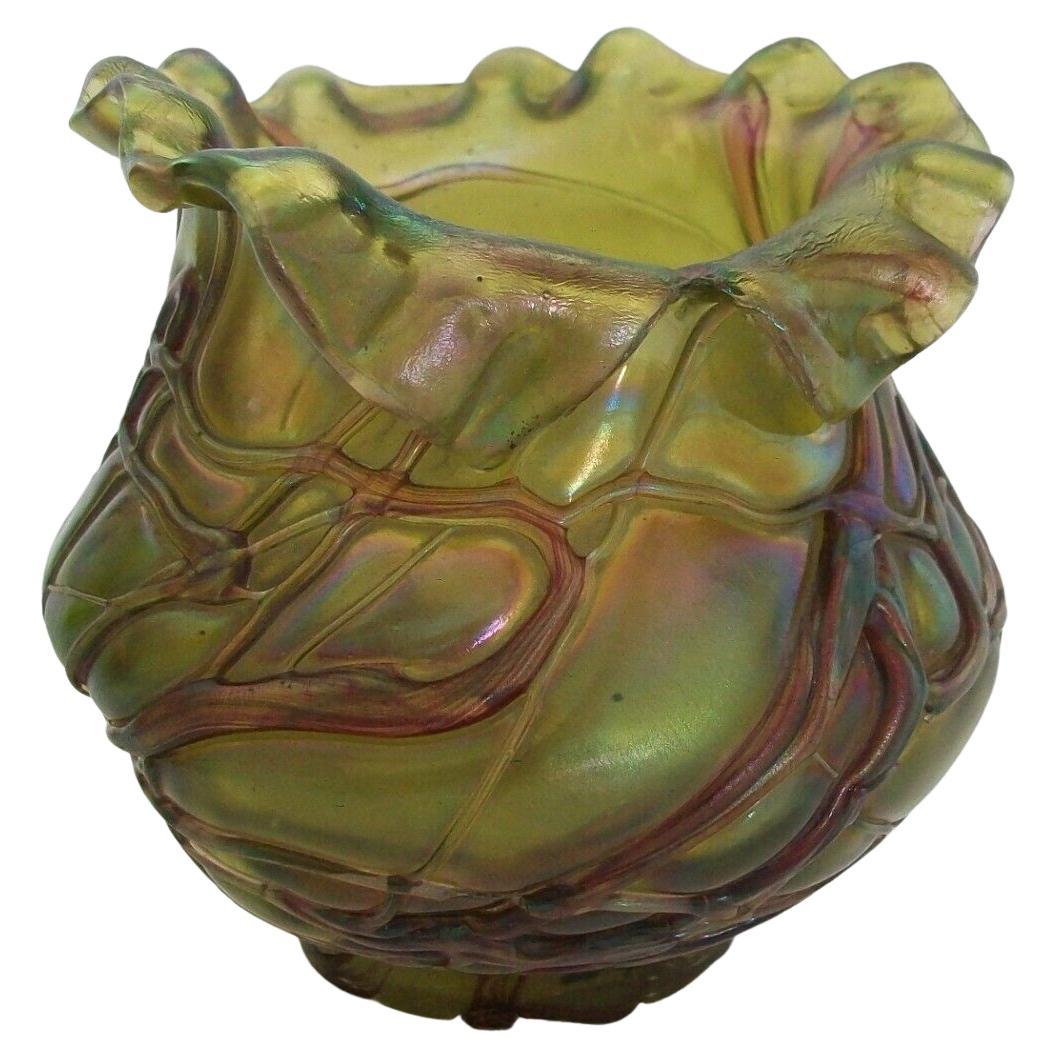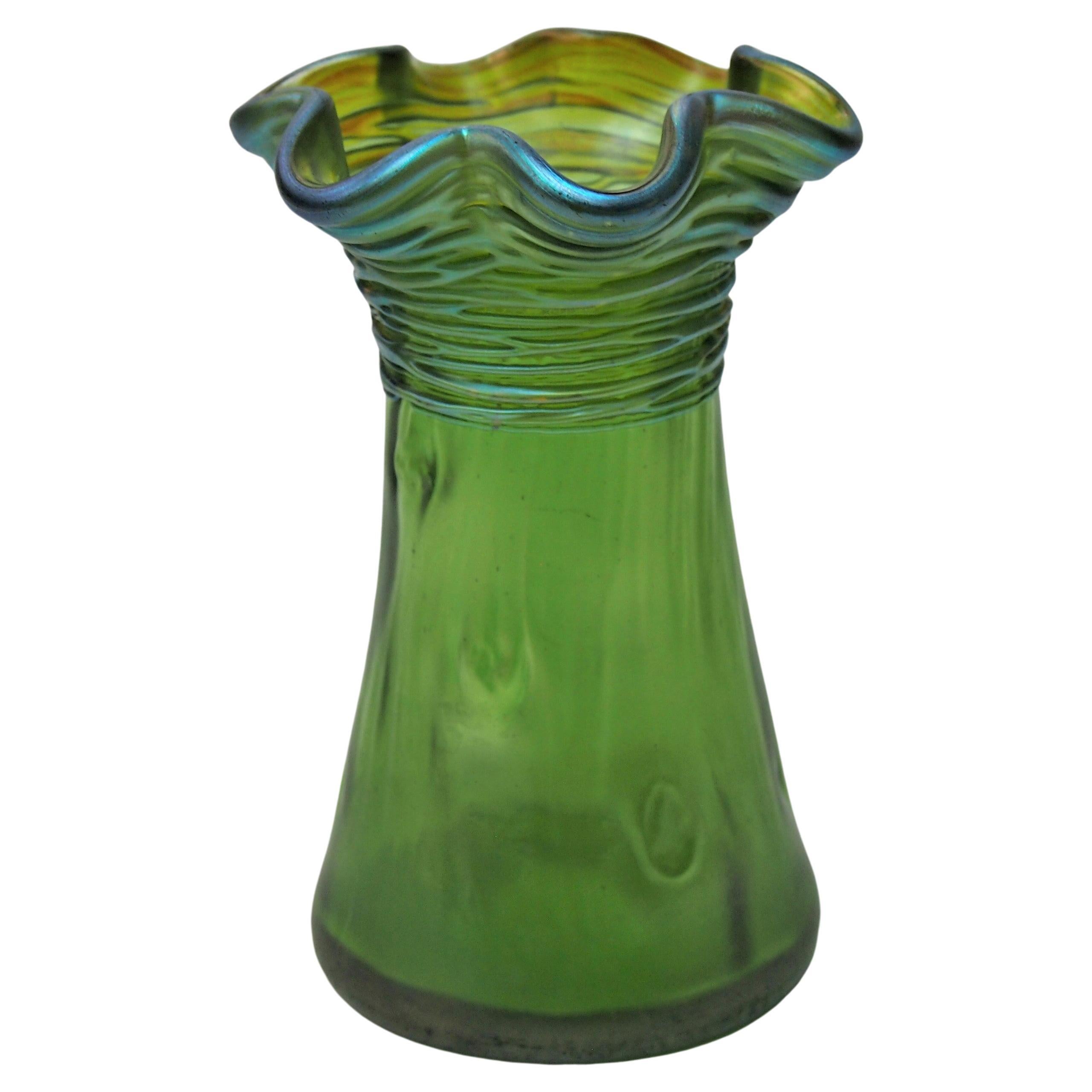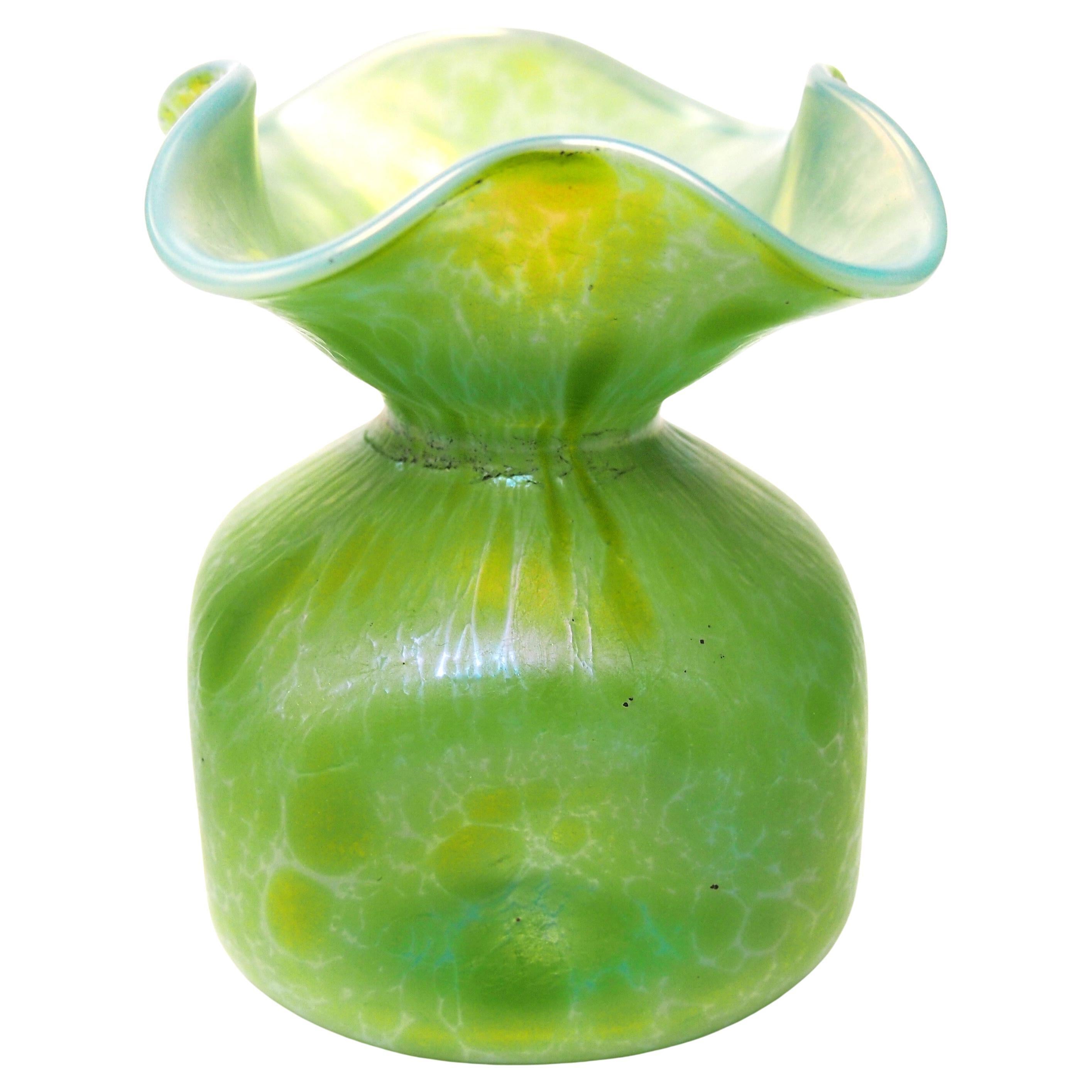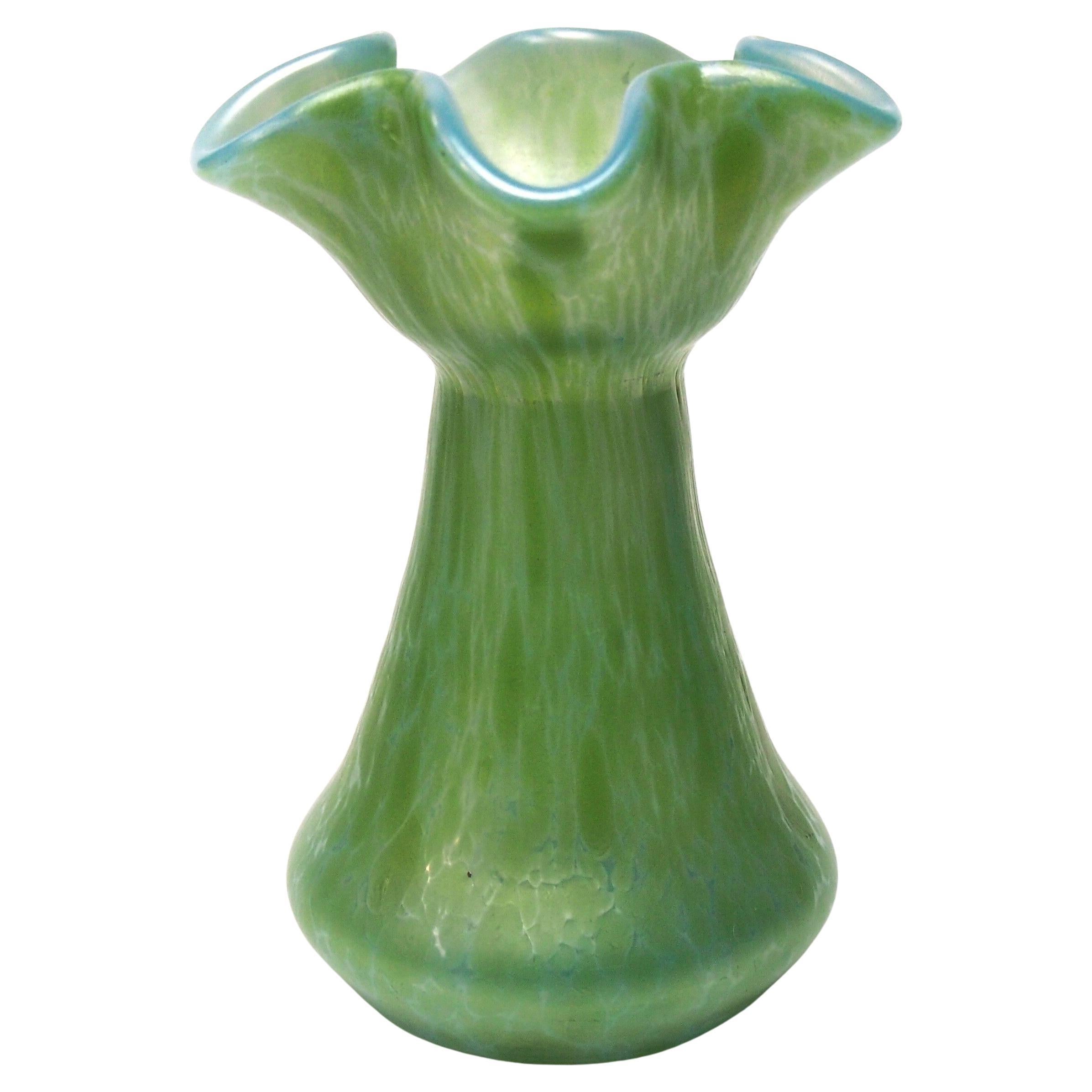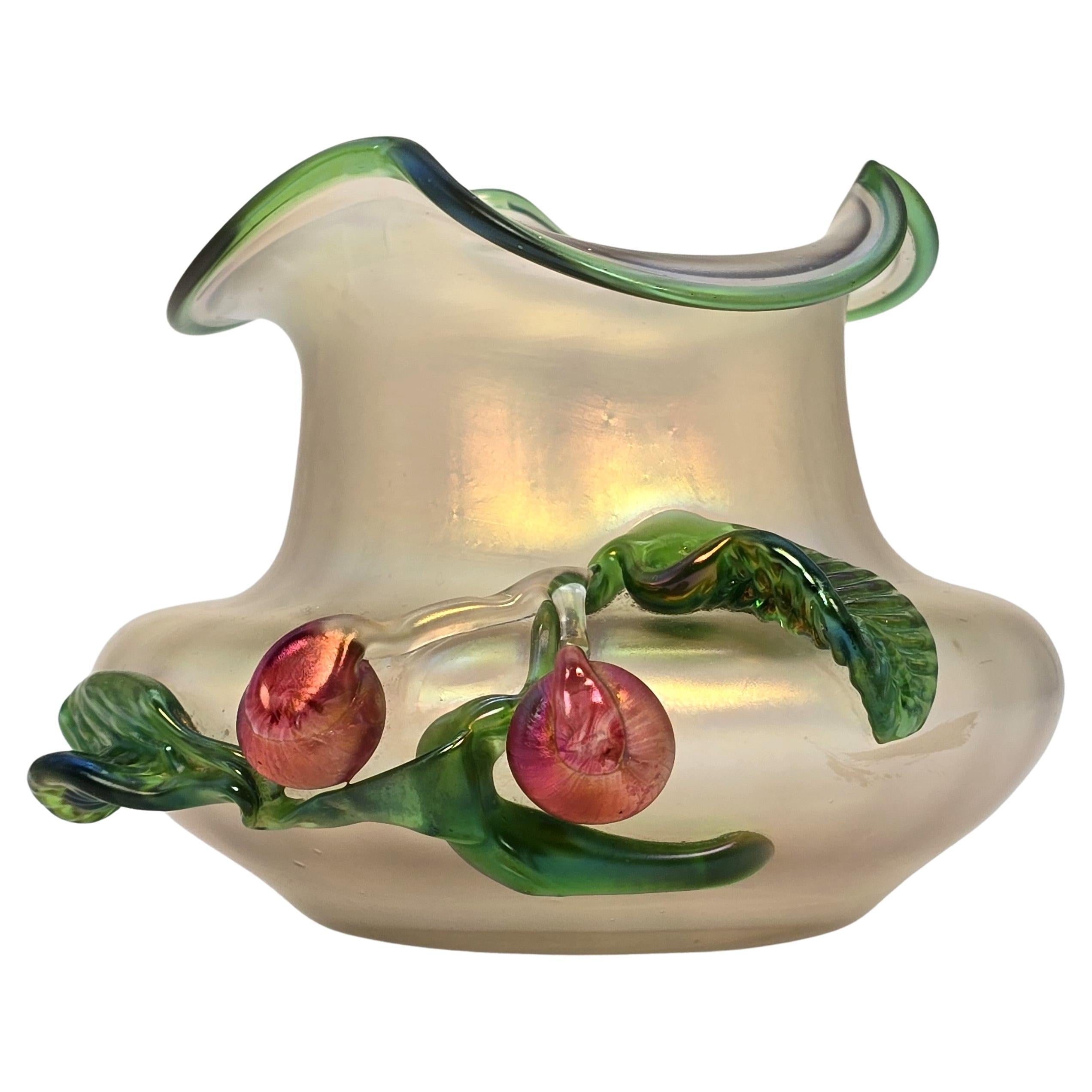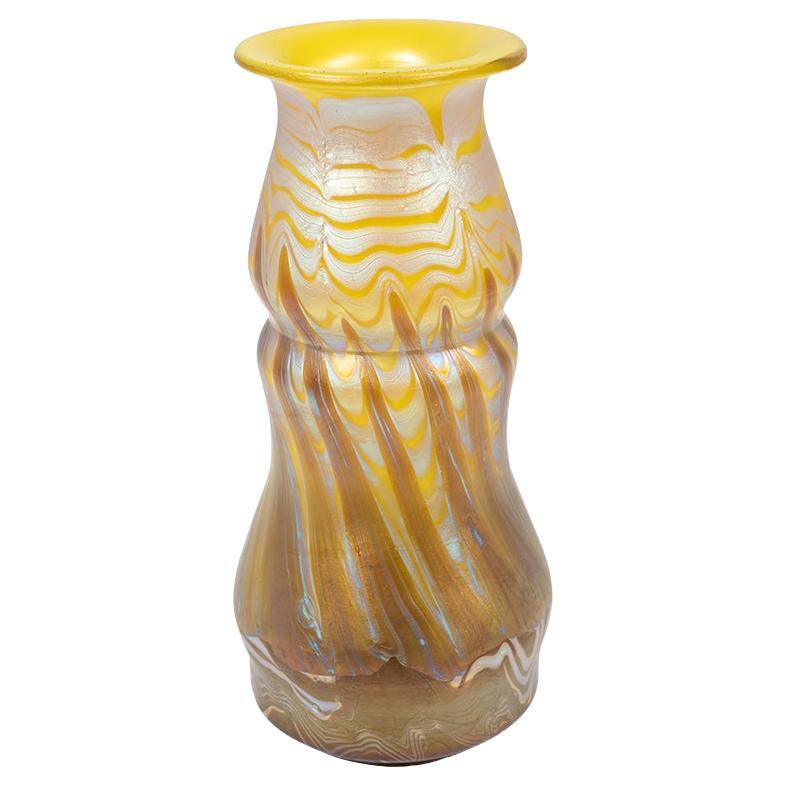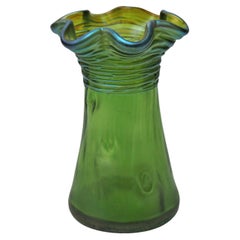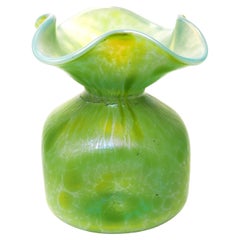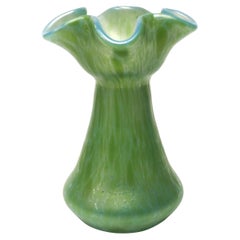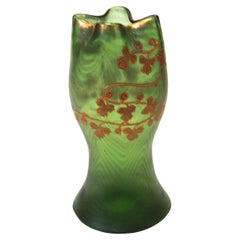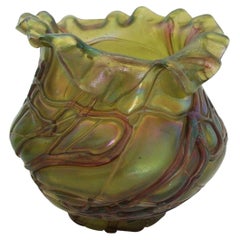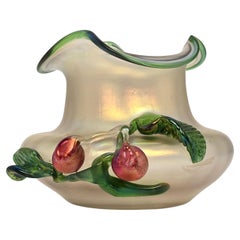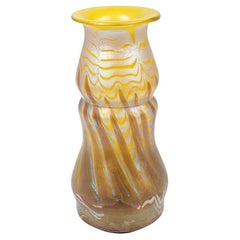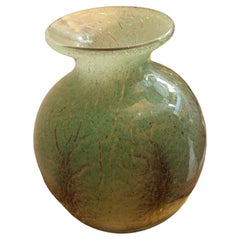Items Similar to Kralik Striefen and Flecken Bohemian Glass Vase c1899
Want more images or videos?
Request additional images or videos from the seller
1 of 7
Kralik Striefen and Flecken Bohemian Glass Vase c1899
$682.41
£495
€578.03
CA$943.56
A$1,035.91
CHF 540.44
MX$12,535.93
NOK 6,773.52
SEK� 6,382.43
DKK 4,314.87
About the Item
A classic Kralik Striefen and Flecken glass vase c1900, a deeply shaped vase with the classic pattern of repeated stripes and circular spots in silver over dark green glass. This particular pattern was later used by Kolo Moser and by Loetz - but this example is an early one made by Kralik. The vase is deeply moulded to produce a complex multi-lobed shape pleasing to the eye -the shape would have been created by a range of tools at the furnace - a great example of hot working.
Kralik was at the time one of the largest Bohemian glass makers only a few miles down the road from Loetz. Along with their brother company (Meyr's Neffe) much of their production was for Lobmeyr.
- Creator:Kralik Glassworks (Manufacturer)
- Dimensions:Height: 4.5 in (11.43 cm)Diameter: 6 in (15.24 cm)
- Style:Art Nouveau (Of the Period)
- Materials and Techniques:
- Place of Origin:
- Period:
- Date of Manufacture:1899
- Condition:Wear consistent with age and use.
- Seller Location:Worcester Park, GB
- Reference Number:Seller: m9581stDibs: LU8313237931182
About the Seller
5.0
Platinum Seller
Premium sellers with a 4.7+ rating and 24-hour response times
1stDibs seller since 2023
34 sales on 1stDibs
Typical response time: 1 hour
- ShippingRetrieving quote...Shipping from: Worcester Park, United Kingdom
- Return Policy
Authenticity Guarantee
In the unlikely event there’s an issue with an item’s authenticity, contact us within 1 year for a full refund. DetailsMoney-Back Guarantee
If your item is not as described, is damaged in transit, or does not arrive, contact us within 7 days for a full refund. Details24-Hour Cancellation
You have a 24-hour grace period in which to reconsider your purchase, with no questions asked.Vetted Professional Sellers
Our world-class sellers must adhere to strict standards for service and quality, maintaining the integrity of our listings.Price-Match Guarantee
If you find that a seller listed the same item for a lower price elsewhere, we’ll match it.Trusted Global Delivery
Our best-in-class carrier network provides specialized shipping options worldwide, including custom delivery.More From This Seller
View AllRare and unusual Bohemian Loetz Crete Rusticana with Threads glass vase c 1899
By Loetz Glass
Located in Worcester Park, GB
A fabulous Art Nouveau Loetz 'Crete' (green) Rusticana with Threads vase -Loetz. The Rusticana décor (instantly recognised by the hand tooled wood knot - like body markings) is quit...
Category
Antique 1890s Czech Art Nouveau Glass
Materials
Art Glass
Bohemia Loetz Art Nouveau Square OzoneCisele Glass Vase 1900-Christopher Dresser
By Christopher Dresser, Loetz Glass
Located in Worcester Park, GB
A fabulous Art Nouveau Ozone Cisele Loetz small vase, of square form with a hand worked wavy top. This is one of a series commissioned by the English retailer Max Emanuel, who regula...
Category
Antique Early 1900s Czech Art Nouveau Glass
Materials
Art Glass
Bohemia Loetz Art Nouveau Round Ozone Cisele Glass Vase 1900-Christopher Dresser
By Loetz Glass, Christopher Dresser
Located in Worcester Park, GB
A fabulous Art Nouveau Ozone Cisele Loetz small vase, of round form with a hand worked wavy top. This is one of a series commissioned by the English retailer Max Emanuel, who regular...
Category
Antique Early 1900s Czech Art Nouveau Glass
Materials
Art Glass
Rare Loetz Phaenomen Vase Crete with rare decor c1898
By Loetz Glass
Located in Worcester Park, GB
A stunning and rare undocumented Loetz Phaenomen vase. Waisted and with a flared foot with four crimps to the top. It is also decorated in raised gold enamelling (a profusion of 3 l...
Category
Antique 1890s Czech Art Nouveau Glass
Materials
Art Glass
Loetz Crete Phaenomen 85/3780 glass vase made exclusively for Bacalowitz c1902
By Loetz Glass
Located in Worcester Park, GB
Fabulous example of a Loetz Phaenomen crete (green based) vase ref 85/3780 made c1902. The green vase is covered in Silver-blue feathering, which has b...
Category
Antique Early 1900s Czech Art Nouveau Glass
Materials
Art Glass
French Early Art Nouveau Emile Galle First Period Enamel Vase, circa 1890
By Émile Gallé
Located in Worcester Park, GB
A very rare Emile Galle, signed, 1st Period vase - enamelled in bold poster colours; Red, Yellow, Blue and Black. The design represents stylised foliage and flowers. Signed 'E Galle...
Category
Antique 1890s French Art Nouveau Glass
Materials
Art Glass
You May Also Like
KRALIK - Art Nouveau 'Threaded' Iridescent Glass Vase, Czech Republic, C.1900
By Kralik Glassworks
Located in Chatham, ON
KRALIK - Antique Art Nouveau iridescent 'threaded' glass vase with dimpled sides and ruffled edge - striking green and red color combination - polished pontil mark to the base - unsi...
Category
Early 20th Century Czech Art Nouveau Glass
Materials
Art Glass
Kralik glass works vase, Bohemian iridescent art glass, Czechoslovakian, C 1900
Located in Central England, GB
This fine example of Bohemian glass design dates to circa 1900. The main body of this stunning vase is of a squat, bulbous form, which flows into a narrow, tapered neck that terminat...
Category
Early 20th Century Czech Other Glass
Materials
Art Glass
Signed Glass Vase Loetz Decoration circa 1900 Art Nouveau Jugendstil Bohemia
By Loetz Glass
Located in Klosterneuburg, AT
Bohemian glass vase, manufactured by Johann Loetz Witwe, PG 356 decoration, ca. 1900, signed, Paris World Exhibition, orange, brown, ochre, silver, white, Bohemia, Viennese Art Nouve...
Category
Early 20th Century Austrian Jugendstil Glass
Materials
Glass
Vase WMF, German, 1900, Style: Art Nouveau, Liberty- Designer - Karl Wiedemann
By Degué
Located in Ciudad Autónoma Buenos Aires, C
WMF (Wurttembergische Metallwarenfabrik)
Electro- Wurtemberg Plate Company in Geislingen, Germany, internationally known today as 'WMF' initials of the company Württembergische Meta...
Category
Antique Early 1900s German Art Deco Glass
Materials
Glass
Vase Loetz , Style : Art Nouveau , Bohemia, circa 1900
By Loetz Glass
Located in Ciudad Autónoma Buenos Aires, C
Loetz
The glass factory, originally founded in 1836 by Johann Baptist Eisner, was taken over. Loetz was the premier Bohemian glass works during this period. It was located in Klostermühle, near Rejštejn in the Sušice district in South-West Bohemia, which belonged to the Austro-Hungarian Empire until 1918. Susanna Loetz, widow of Glass entrepreneur Johann Loetz in 1852. She renamed the company "Glasfabrik Johann Loetz Witwe", a name that was retained until all activities were stopped in 1947. In 1879 it passed to Max Ritter von Spaun. Under his guidance, together with director Eduard Prochaska, the glassworks flourished as never before and enjoyed its most successful period. Von Spaun and Prochaska concentrated on the development of innovative glass types and new production techniques. Their first successful speciality was a glass type simulating semiprecious stones. It is often called "Marmoriertes Glas" ("marbled glass"). The range contained Onyx (red/brown), Karneol (red/pink) and later Malachit (green). It was introduced in the second half of the 1880's. From the same period dates the Octopus glass, of which the decor resembles the tentacles of a cephalopod. The production of Marmorier-tes Glas was resumed in 1906, in different colours like yellow and white. Octopus, 1885-1890, 1885-1890, unknown, an Malachit, 1885-1890, unknown, The master glass-blowers of Klostermühle had already carried out experiments with iridescence in the first half of the 1890's, and they produced the Olympia, a classically inspired olive green type, in 1896. Similar, in variants of creta green, bronce or Olympia and averse to any redundant decoration was the Glatt decor. It highly contrasted with the more elaborate finishes of that time, but it constitutes a part of the production with a deep sense for taste and quality. Most of the pieces shown in the "Glatt" decors were manufactured for Max Emmanuel in London.
The glatt decor remained in use for many years. The Chiné decor had thin glass threads spun around the body in irregular patterns. It is not to be confused with the type of glass that was produced by Kralik. Loetz "Chiné" came in clear, opal, green and pink, Kralik "Chiné" in dark purple. The logical sequel to Chiné was the Pampas decor, green or cobalt blue, in which the threads almost disappeared in the surface, with iridised parts in between. Around the same time the dotted Papillon decor was introduced. The beautiful silver spots were employed on a wide array of models and quite effective on the gooseneck (water sprinkler) and sea shell...
Category
Antique Early 1900s Austrian Art Nouveau Glass
Materials
Art Glass
Jugendstil Glass Vase, circa 1908
Located in Wien, AT
Jugendstil glass vase, circa 1908
Original condition.
Category
Antique Early 1900s Czech Jugendstil Vases
Materials
Glass
More Ways To Browse
Green Bohemian Czech
Kolo Moser
Blue Stemware
Bohemian Beaker
Bohemian Glass Beaker
Cenedese Tumbler
Champagne Sherbet Glasses
Cobalt Wine Glasses
Czech Bohemian Glass Goblet And Cover
Czech Coupe
Eapg Glass
Egermann Ruby
Fostoria Art Glass
Fused Glass Tray
Glass Flacon Murano
Glass Hutte
Irish Whiskey
Lalique Angel Glass
